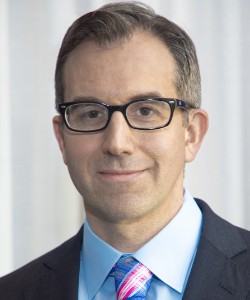President’s Message: Cultivating Global Friendships and Partnerships with our Sister Societies
Cite as: Provenzano D. President’s message: cultivating global friendships and partnerships with our sister societies. ASRA Pain Medicine News 2023;48. https://doi.org/10.52211/asra110123.001.

At ASRA Pain Medicine, our vision is to relieve the global burden of pain. Initially, when hearing this vision, you might say that this is a grandiose idea that will not be possible to attain. Clearly this vision is not achievable without working with global partners and expanding outreach. However, after returning from the 6th World Congress on Regional Anaesthesia and Pain Medicine (WCRAPM) in Paris and meeting with the members and leadership of the respective sister societies, including the European Society of Regional Anaesthesia and Pain Therapy (ESRA), Latin American Society of Regional Anesthesia (LASRA), Asian & Oceanic Society of Regional Anaesthesia and Pain Medicine (AOSRA-PM), and the African Society of Regional Anesthesia (AFSRA), I believe this vision is possible. As I stated in my first President’s Message, to expand ASRA Pain Medicine’s reach, we need to cultivate relationships and partnerships, especially with our international colleagues.
The World Congress brought together the leadership and membership of our sister societies. The event was highly organized, educational, and enjoyable. The education provided was first class, and it was a gift to be able to learn and share knowledge with members around the globe. I was intrigued by the similarities and differences in pain care delivery. ESRA did a phenomenal job hosting the World Congress, and their hospitality is unmatched.

After attending the World Congress, I thought it would be helpful for the ASRA Pain Medicine membership to learn about each sister society. Leaders from each society were kind enough to write summaries of each respective society. I hope you realize we have so much in common, and the vision to relieve the global burden of pain is possible with society teamwork.
I am also happy to announce that under the leadership of Vivian Ip, the editor of ASRA Pain Medicine News, and the commitment of the sister societies to exchanging information, we will have strong collaboration between the respective newsletter committees with dedicated articles occurring in a regular cadence. These collaborative pieces will be highlighted with special collaborative logos. They will also be on social media, so do follow #ASRANews. Furthermore, the hyperlinks of the other sister societies’ news will be on our website under News & Publications, so international regional anesthesia and pain medicine news will be at your fingertips.

Joining Hands for Global Excellence — Discovering Our Sister Societies: Alliance with the European Society of Regional Anaesthesia (ESRA) — Eleni Moka, MD, President
Founded in 1982, ESRA is a dynamic organization dedicated to advancing education, scientific research, and training in regional anesthesia, perioperative care, and pain medicine. ESRA has grown from its European routes into a global network with more than 7,500 active members and an audience of 30,000 trainees, specialists, and nurses.
In September, ESRA hosted the 6th WCRAPM in Paris. This event was a collaboration with sister societies and attracted more than 3,000 delegates and 300 faculty members from around the world. The congress provided high-quality scientific content, networking opportunities, and a platform for knowledge sharing and the exchange of new ideas.
ESRA is committed to disseminating cutting-edge knowledge and providing intense hands-on training through various scientific events. The society places great emphasis on supporting trainees and young specialists, recognizing them as the future of medical care. ESRA offers research and education grants to young researchers worldwide and encourages them to apply. The society also provides approved Training Centers of Excellence for physicians, particularly those from countries lacking the financial infrastructure needed for education in regional anesthesia and pain medicine.
Furthermore, ESRA strives to be at the forefront of evidence-based medicine. In collaboration with ASRA Pain Medicine and other sister societies, it develops regional anesthesia and pain medicine guidelines. Recently. ESRA and ASRA Pain Medicine developed consensus practice guidelines on postdural puncture headache. The society also has a working group for PROSPECT (Procedure Specific Postoperative Pain Management), which was originally formed in 2002 as an independent body but has been within the ESRA academic umbrella since 2014. PROSPECT has developed consensus recommendations covering 20 common surgical procedures and will continue to develop guidelines covering more surgical procedures. Education and excellence in care provision are integral parts of ESRA’s mission. The society offers two diplomas, The ESRA Diploma on Regional Anaesthesia & Acute Pain Management and the ESRA Diploma on Pain Medicine. These diplomas aim to harmonize and improve quality standards for safe, independent practice in Europe and elsewhere.
In the era of rapid e-learning transformation, ESRA has adapted its educational content to the new digitally-driven world. It offers access to the UltraSound Airway Breathing Circulation Dolor platform, a unique e-learning concept that provides knowledge of regional anesthesia and point-of-care ultrasound in clinical practice.
Lastly, ESRA values diversity within its community and offers unparalleled networking opportunities. It collaborates with sister societies that share similar principles to enhance discussions and provide a global outlook on their fields of interest. The International Committee within ESRA gives a voice to physicians from all continents involved in regional anesthesia and pain medicine. The European Day of Regional Anesthesia is a highlight event that promotes interactivity and exchange of scientific opinions between trainees and experts on hot topics related to regional anesthesia.
ESRA’s primary goal is to discuss innovations and combine theory with clinical methodology and hands-on practice. By doing so, ESRA continues to promote knowledge, encourage training, education, and research, and improve the quality of continuing medical education among European anesthesiologists. ESRA aspires to expand this activity worldwide to fulfill its mission. The organization of the World Day of Regional Anesthesia is a goal within reach!
Throughout its journey, ESRA has expanded its horizons and pushed boundaries to become an international community for those who aspire to high standards and professionalism in regional anesthesia, perioperative care, and pain medicine. Despite challenges, ESRA stands as a testament to the power of inclusivity and collaboration in our ever-evolving fields of interest. By joining efforts, we can create a vibrant tapestry of ideas, expertise, and shared values.
As we embark on this journey together, let’s remember that unity brings strength, and inclusion fosters boundless potential for growth and innovation. Our individual strengths, when combined, can collectively achieve remarkable advancements in the pursuit of knowledge, scientific research, and patient care. ESRA continues to extend the hand of partnership to all sister societies that share its vision, ensuring a brighter, more inclusive future as we strive for global excellence.
Partnership with the Asian & Oceanic Society of Regional Anaesthesia and Pain Medicine (AOSRA-PM) — Dr. J. Balavenkat, Past-President
AOSRA-PM was established in 1989, and incorporated pain medicine in 2001. AOSRA-PM is a conglomerate of large member countries spanning across Southeast Asia, Northeast Asia, North Asia, East Asia, South Asia, Western Asia, and Oceania, each represented by a board of directors, who serves as the primary contact for their respective country/region. Despite the vast geographical diversity, the members of the society have worked diligently to grow together and learn from each other through monthly webinars and fellowships.
The AOSRA-PM traveling fellowship, which was recently initiated, provides our next generation of young anesthesiologists with the opportunity to explore and learn new skills and knowledge in regional anesthesia and pain management from other countries within our society.
The next meeting of AOSRA-PM is scheduled for September 27 and 28, 2024, in Danang, Vietnam. The society looks forward to collaborating with ASRA Pain Medicine in several areas including education, research, and advocacy. This is a testament to AOSRA-PM’s commitment to lifelong learning, development, and growth through collaboration within our subspecialty.
Collaboration with the African Society for Regional Anesthesia (AFSRA) — Dr. Ezzat Aziz, President
AFSRA was established in 2010 with the mission to improve patient care by advancing the science and practice of regional anesthesia in Africa. Despite financial constraints and the challenges faced by African doctors, AFSRA has grown into a significant organization with 250 members.
AFSRA is dedicated to disseminating knowledge and encourages its members to research regional anesthesia and pain medicine. The society organizes several workshops and courses annually in different parts of Africa. In the era of virtual delivery of educational content, anesthesiologists within the AFSRA membership can attend webinars delivered by experts in the subspecialty. Looking towards the future, AFSRA hopes to increase funding for travel tours to reach more sub-Saharan African countries and sustain regional anesthesia resources in these regions.
While AFSRA is committed to education and research, the financial strain on African doctors does impact our ability to fund external/international speakers. Therefore, we do rely on support from our sister societies to fund speakers to deliver lectures and teach at our annual meetings so that AFSRA members can benefit from the experience and knowledge of international expertise with equitable teaching and education opportunities. Through the collaboration between AFSRA and ASRA Pain Medicine, as well as other sister societies, this knowledge transfer can only be strengthened. This also means that we are closer to achieving our ultimate goal, providing members with first-class education and technical skills to facilitate safe, efficacious, and high-quality patient care. Another important aspect is to promote robust research and audit practices in the field of regional anesthesia and pain management in Africa. This will contribute to the development of evidence-based practices tailored to the unique needs of the African context.
Our society values objectivity, transparency, and integrity. It welcomes change, encourages invention, and continually seeks better, more efficient ways to achieve its goals.
Working Together with the Latin American Society of Regional Anesthesia (LASRA) — Dr. Juan Carlos De la Cuadra-Fontaine, President
LASRA was established in March 1993, with Dr. José Carvalho as the first president. Unfortunately, we lost our key leader, who left for Canada 5 years later. Despite the initial challenges, LASRA has slowly regained momentum and is now making significant strides in the field of regional anesthesia.
While neuraxial techniques have long been practiced in Latin America, peripheral nerve blocks have been slow to take off although we are now catching up. Therefore, it is our mission to disseminate valuable knowledge and techniques to LASRA members, including those from the lower-income countries, who have not “grown up” in the era of ultrasound-guided regional anesthesia. We also recognize the importance of incorporating chronic pain medicine into our society, bringing these subspecialists together to share and learn from each other.
LASRA currently serves members across 14 different countries, namely, Argentina, Bolivia, Brazil, Chile, Colombia, Costa Rica, Ecuador, Honduras, Mexico, Panamǎ, Paraguay, Peru, Uruguay, and Venezuela. Each relies on local national LASRA groups to deliver education materials in regional anesthesia and pain medicine. Virtual platforms have helped LASRA reach a wider audience across many different regions simultaneously. Nonetheless, the annual meeting remains LASRA’s most important activity for its members.
While LASRA recognizes the importance of advancing knowledge and skills through research, it is not part of the curriculum at medical schools or specialty programs in most of the countries where our members are from, and there is insufficient investment in supporting clinical research at the corresponding hospitals. However, LASRA encourages its members to publish prospective case series of innovative practices and continues to seize any research opportunities. Through collaboration with the ASRA Pain Medicine newsletter team, members will be encouraged to share their knowledge and skills through a different platform of scientific writing.
LASRA's growth and influence were evident at the World Congress in Paris, where 15 of its members delivered excellent presentations as faculty members. LASRA is preparing to host the 7th WCRAPM in 3 years' time and is eager to impress the world with its achievements.